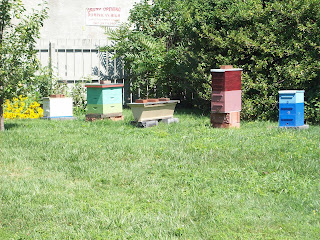 |
| N is for Nasturtium |
We came to MSU in East Lansing to attend the Symposium on Children and Youth Gardening. As I expected, I got to play and explore in the 4-H Children’s Garden on the MSU campus. Even in the blistering sunshine and later welcome rain, it was a glorious place to be!
 |
| chimes |
 |
| green roof over outdoor classroom area |
An unexpected highlight of this year’s AHS Symposium was the time I got to spend with Jane Taylor. She attended our presentation on Thursday morning, and we visited off and on throughout the almost four days. The symposium ended with Jane delivering the final keynote address. I learned so much from her and truly enjoyed her positive spirit, sense of humor, energy, and breadth of knowledge and understanding of children, plants, gardens and their joyful intersection! In 2003 she closed her AHS Symposium speech with:
In this next century it's an unbeatable combination -- children connecting with the natural world through garden-based activities by interacting with living plants and then connecting to AHS resources via computer technology. The simple early aims are still the same-to create gardens to open children's minds, to touch their hearts and souls, and to let imagination's soar while teaching them the basic principles of gardening and science using the common things and fun experiences in their environment.
Today in her closing speech she took a different approach. She taught us of the great role that MSU (and its teachers) has played down through the years. As the first land grant college (beating Penn State by a few months.... They’re a Big 10 rival now...) in the US, Michigan Agricultural College became the incredible institution that we know today as Michigan State University. William James Beal was one of the group of 6 professors here at its beginnings. Along with all his many teaching responsibilities, he created what is now the oldest continuously operating botanical garden. He had Liberty Hyde Bailey as one of his students, a botanist who is considered along with Anna Botsford Comstock to have founded the Nature Study movement. These are two of my early heroes, but I learned today of how L.H.Bailey also helped create the federal laws that founded the Ag Extension system and our current 4-H clubs! As she closed her speech today, Jane congratulated and thanked the future teachers, scientists and gardeners who will continue this important work. It was a fine and optimistic closing to a great symposium.
Jane Taylor played a major part in this ongoing lineage, herself. She helped to design and install the first real children’s garden. Yes, the one here in East Lansing. Prior to this garden in 1993, children visiting gardens were requested, cajoled and scolded to be careful and certainly not to play on the sculptures! (Kind of like how we had to call the Philadelphia Museum of Art the “Please Don’t Touch Museum” for my boys.)
Here though at the 4-H Children’s Garden, kids are invited to explore, to use their bodies and minds together, to climb, jump, and hide as they learn about the world of plants and nature. Many similarly active gardens have been formed since then, often in consultation with Jane. I look forward to traveling and finding as many of them as I can in the years ahead!
Thank you Jane!
Written by Fern





















































